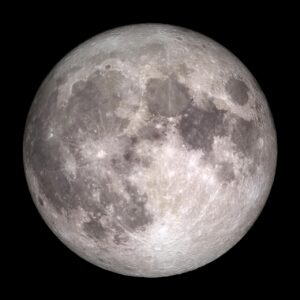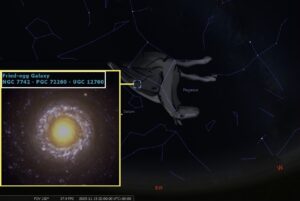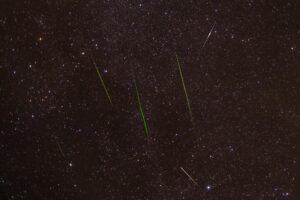Remember, remember to look up in November! Yes this optimum time of year for celestial observing has a whole goodie bag of autumnal treats to be enjoyed throughout the month – so plant some sparklers or toffee apple sticks on these dates in your diary to keep yourself inspired by Space as our night sky gets a step closer to ‘astronomical twilight’ and a warm coat is still all that you need outdoors…
Listen out for wolves howling for the Full Moon on the 5th November when Earth’s biggest satellite and closest neighbour in Space will be at maximum brightness and we’ll be able to observe the full ‘daytime’ side of the Moon in all its glory – weather permitting. As the Sun’s mirrored light from Earth’s nocturnal lantern will be turned up to the ‘max’, apparent magnitude: -13 (the negative number inversely signifying a brighter magnitude), this should be the perfect evening for a night off from star-gazing as many constellations will already be moving ‘back stage’ while the Supermoon seeks our full and undivided attention in the south-eastern part of the night sky.
As the best time to see the planets and the stars is when the brightest object in the night sky is hidden from view and busy orbiting around the daytime side of our planet – we can observe the 2 biggest planets of our Solar System any evening with clear skies between the 11th and 26th of the month. At 10pm Jupiter should be visible low in the northern sky with the appearance of a particularly large white-looking star, gradually moving NE towards the end of the month. If you then swing round on your heel to face south, Saturn will be found higher in the sky, disguised as a star of average brightness with a slightly golden complexion to give you a clue as to its true identity. Remember that a distinctive lack of ‘twinkle’ can be your guide to identifying celestial objects in our local vicinity in Space (such as planets) as opposed to a star or deep Space object trillions of miles from Earth.
Find the pleasingly tidy shape of ‘The Great Square’ in the south, then join a few more stars to add the bent neck, head and front hooves to the RHS of the square to complete the constellation of the winged horse – Pegasus, and don’t forget this mythical horse is a bit of a show-off, flying upside down! Pegasus certainly had some magic, as it contains a stunning galaxy that we are able view directly from above, allowing us appreciate its perfect round shape. Moreover, galaxy NGC7742, discovered by the famous German-British astronomer William Herschel in 1784 seems to defy the conventional understanding of what a barred spiral galaxy should look like, with no apparent ‘bar’ across the centre, but instead a perfect circular ring. The spectacular yolk-like centre , unusually dense with stars is thought to have possibly been created by a second dwarf galaxy that merged with a larger one, increasing the star population dramatically, helping to give this star city its most fitting nickname – the Fried Egg Galaxy!
Although meteor observation can be unpredictable, there are no less than 3 meteor showers at this time of year to increase our chances of seeing a piece of rock or dust from Space (on average, the size of a grain of sand)- burning up thanks to atmospheric friction as it blazes through Earth’s upper atmosphere at a mind-blowing speed of up to 250 000 km per hour. Meteor showers are named after the patch of our night sky that they appear to radiate from. So as the entire night sky (or celestial sphere as it’s known in astronomy), is divided up like an invisible jigsaw into different ‘pieces’ each marked out by a different star pattern or constellation, then the shooting stars take their name from the specific constellation that they appear to come from. This month Earth passes through the debris trails of 3 comets that sprinkle meteoroids into our sky through the constellations of Taurus, Leo, and Orion. The Leonids are particularly bright meteors and fast-moving, visible between the 6th-30th of November, so if you are out and about, keep your eyes peeled for any streaks of light across the sky – with the peak of the shower taking place on the night of the 17th through to the next morning. Although the Orionids’ peak was last month, you may still be able to spot some until the 7th November. The Taurids peak is on the 12th night and will potentially be active throughout the entire month.
After crunching over the autumn leaves and tracking down celestial wonders in the cool night air – it’s time to warm up with some soup… so reach to the north for the handle of the ‘Big Dipper’, your very own stellar saucepan in the heavens!







0 Comments